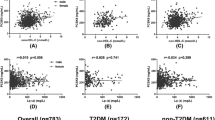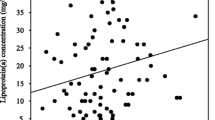Abstract
Objective
To investigate the effects of Hedan Tablet (荷丹片) on serum lipid profile, proprotein convertase subtilisin/kexin type 9 (PSCK9) and high-density lipoprotein (HDL) subfractions in patients with hyperlipidemia.
Methods
Thirty-seven patients with hyperlipidemia were randomized to treatment with Hedan Tablet 4.38 g/day as Hedan group (18 cases) or placebo (19 cases) as control group for 8 weeks. The lipid profile, PCSK9 and HDL subfractions were determined at day 0 and week 8 in both groups respectively.
Results
Hedan treatment for 8 weeks mildly decreased serum low-density lipoprotein cholesterol (LDL-C) levels, while no changes were found in total cholesterol (TC), triglycerides (TG) and PCSK9 concentrations. Furthermore, Hedan treatment increased the concentration of large high-density lipoprotein cholesterol (HDL-C) and the percentage of large HDL subfraction, while decreased the concentration of small HDL-C and the percentage of small HDL subfraction without changing serum HDL-C levels in patients with hyperlipidemia.
Conclusion
Hedan treatment of 4.38 g per day for 8 weeks could confer a favorable effects on serum LDL-C concentration as well as HDL subfractions.
Similar content being viewed by others
References
Satoh H, Nishino T, Tomita K, Tsutsui H. Fasting triglyceride is a significant risk factor for coronary artery disease in middle-aged Japanese men—results from a 10-year cohort study. Circ J 2006;70:227–231.
Mahalle N, Garg MK, Naik SS, Kulkarni MV. Study of pattern of dyslipidemia and its correlation with cardiovascular risk factors in patients with proven coronary artery disease. Indian J Endocrinol Metab 2014;18:48–55.
Dou XB, Wo XD, Fan CL. Progress of research in treatment of hyperlipidemia by monomer or compound recipe of Chinese herbal medicine. Chin J Integr Med 2008;14:71–75.
Soltani R, Hakimi M, Asgary S, Ghanadian SM, Keshvari M, Sarrafzadegan N. Evaluation of the effects of Vaccinium arctostaphylos L. fruit extract on serum lipids and hs-CRP levels and oxidative stress in adult patients with hyperlipidemia: a randomized, double-blind, placebocontrolled clinical trial. Evid Based Complement Alternat Med 2014;2014:217451.
Seidah NG, Prat A. The biology and therapeutic targeting of the proprotein convertases. Nat Rev Drug Discov 2012;11:367–383.
Jia YJ, Zhang Y, Liu J, Guo YL, Xu RX, Li JJ. Short-and long-term effects of Xuezhikang, an extract of cholestin, on serum proprotein convertase subtilisin/kexin type 9 levels. Chin J Integr Med 2014 Jul 4. [Epub ahead of print]
Horton JD, Cohen JC, Hobbs HH. PCSK9: a convertase that coordinates LDL catabolism. J Lipid Res 2009;50:S172–S177.
Seidah NG. PCSK9 as a therapeutic target of dyslipidemia. Expert Opin Ther Targets 2009;13:19–28.
Welder G, Zineh I, Pacanowski MA, Troutt JS, Cao G, Konrad RJ. High-dose atorvastatin causes a rapid sustained increase in human serum PCSK9 and disrupts its correlation with LDL cholesterol. J Lipid Res 2010;51:2714–2721.
Awan Z, Seidah NG, Mac Fadyen JG, Benjannet S, Chasman DI, Ridker PM, et al. Rosuvastatin, proprotein convertase subtilisin/kexin type 9 concentrations, and LDL cholesterol response: the JUPITER trial. Clin Chem 2012;58:183–189.
Raal F, Panz V, Immelman A, Pilcher G. Elevated PCSK9 levels in untreated patients with heterozygous or homozygous familial hypercholesterolemia and the response to high-dose statin therapy. J Am Heart Assoc 2013;2:e000028.
Careskey HE, Davis RA, Alborn WE, Troutt JS, Cao G, Konrad RJ. Atorvastatin increases human serum levels of proprotein convertase subtilisin/kexin type 9. J Lipid Res 2008;49:394–398.
Wen C, Xu H. The new strategy for modulating dyslipidemia: consideration from updated understanding on high-density lipoprotein. Chin J Integr Med 2011;17:467–470.
Barter PJ, Rye KA, Tardif JC, Waters DD, Boekholdt SM, Breazna A, et al. Effect of torcetrapib on glucose, insulin, and hemoglobin A1c in subjects in the Investigation of Lipid Level Management to Understand its Impact in Atherosclerotic Events (ILLUMINATE) trial. Circulation 2011;124:555–562.
Michos ED, Sibley CT, Baer JT, Blaha MJ, Blumenthal RS. Niacin and statin combination therapy for atherosclerosis regression and prevention of cardiovascular disease events: reconciling the AIM-HIGH (Atherothrombosis Intervention in Metabolic Syndrome With Low HDL/High Triglycerides: Impact on Global Health Outcomes) trial with previous surrogate endpoint trials. J Am Coll Cardiol 2012;59:2058–2064.
Group HTC. HPS2-THRIVE randomized placebo-controlled trial in 25 673 high-risk patients of ER niacin/laropiprant: trial design, pre-specified muscle and liver outcomes, and reasons for stopping study treatment. Eur Heart J 2013;34:1279–1291.
Superko HR, Pendyala L, Williams PT, Momary KM, King SB, Garrett BC. High-density lipoprotein subclasses and their relationship to cardiovascular disease. J Clin Lipidol 2012;6:496–523.
Rosenson RS, Brewer HB, Chapman MJ, Fazio S, Hussain MM, Kontush A, et al. HDL measures, particle heterogeneity, proposed nomenclature, and relation to atherosclerotic cardiovascular events. Clin Chem 2011;57:392–410.
Barylski M, Toth PP, Nikolic D, Banach M, Rizzo M, Montalto G. Emerging therapies for raising high-density lipoprotein cholesterol (HDL-C) and augmenting HDL particle functionality. Best Pract Res Clin Endocrinol Metab 2014;28:453–461.
Kingwell BA, Chapman MJ, Kontush A, Miller NE. HDLtargeted therapies: progress, failures and future. Nat Rev Drug Discov 2014;13:445–464.
Wan FC, Huang DZ. Hypolipidemic effect of Hedan Tablet. Chin J Exp Tradit Med Form (Chin) 1996;2:19–21.
Hu YY. Evaluation of efficacy and safety for Hedan treatment in patients with dyslipidemia. Chin J Integr Med Cardio-/Cerebrovasc Dis (Chin) 2013;11:1135–1136.
Goliasch G, Oravec S, Blessberger H, Dostal E, Hoke M, Wojta J, et al. Relative importance of different lipid risk factors for the development of myocardial infarction at a very young age (</= 40 years of age). Eur J Clin Invest 2012;42:631–636.
Christogiannis LG, Kostapanos MS, Tellis CC, Milionis HJ, Tselepis AD, Elisaf MS. Distinct effects of fixed combinations of valsartan with either amlodipine or hydrochlorothiazide on lipoprotein subfraction profile in patients with hypertension. J Hum Hypertens 2013;27:44–50.
Tian Q, Gu SY, Liu YF. Effect of Hedan on lipid profile in patients with hypetlipidemia. Chin J Integr Med Cardio-/Cerebrovasc Dis (Chin) 2013;11:1290–1291.
Fu XL, Zhan QL, Meng FJ, Ying YH, Tian XY, Yang YB, et al. Effects of Hedan Tablet on lipid pfrofile and vasscular endothelial function in elder hyperlipidemic patients. Modern J Integr Tradit Chin West Med (Chin) 2013;22:4015–4016.
Chen YL. The intervention effect of Hedan Tablet combined with atorvastatin on cytokine in carotid atherosclerosis. Chin J Integr Med Cardio-/Cerebrovasc Dis (Chin) 2013;10:808–810.
Wang L, Zheng GN. Comparation of the effects between Hedan and atorvastatin on lipid profile in patients with hyperlipidemia. Chin J Ethnomed Ethnopharm (Chin) 2012;24:61–62.
Seidah NG, Prat A. The biology and therapeutic targeting of the proprotein convertases. Nat Rev Drug Discov 2012;11:367–383.
Urban D, Pöss J, Böhm M, Laufs U. Targeting the proprotein convertase subtilisin/kexin type 9 for the treatment of dyslipidemia and atherosclerosis. J Am Coll Cardiol 2013;62:1401–1408.
Welder G, Zineh I, Pacanowski MA, Troutt JS, Cao G, Konrad RJ. High-dose atorvastatin causes a rapid sustained increase in human serum PCSK9 and disrupts its correlation with LDL cholesterol. J Lipid Res 2010;5:2714–2721.
Barylski M, Toth PP, Nikolic D, Banach M, Rizzo M, Montalto G. Emerging therapies for raising high-density lipoprotein cholesterol (HDL-C) and augmenting HDL particle functionality. Best Pract Res Clin Endocrinol Metab 2014;28:453–461.
Salonen JT, Salonen R, Seppanen K, Rauramaa R, Tuomilehto J. HDL, HDL2, and HDL3 subfractions, and the risk of acute myocardial infarction. A prospective population study in eastern Finnish men. Circulation 1991;84:129–139.
Fendler W, Rizzo M, Borowiec M, Malachowska B, Antosik K, Szadkowska A, et al. Less but better: cardioprotective lipid profile of patients with GCK-MODY despite lower HDL cholesterol level. Acta Diabetol 2014;51:625–632.
Xu RX, Guo YL, Li XL, Li S, Li JJ. Impact of short-term low-dose atorvastatin on low-density lipoprotein and high-density lipoprotein subfraction phenotype. Clin Exp Pharmacol Physiol 2014;41:475–481.
Author information
Authors and Affiliations
Corresponding author
Rights and permissions
About this article
Cite this article
Xu, Rx., Wu, Nq., Li, S. et al. Effects of Hedan Tablet (荷丹片) on lipid profile, proprotein convertase subtilisin/kexin type 9 and high-density lipoprotein subfractions in patients with hyperlipidemia: A primary study. Chin. J. Integr. Med. 22, 660–665 (2016). https://doi.org/10.1007/s11655-015-2140-3
Received:
Published:
Issue Date:
DOI: https://doi.org/10.1007/s11655-015-2140-3




